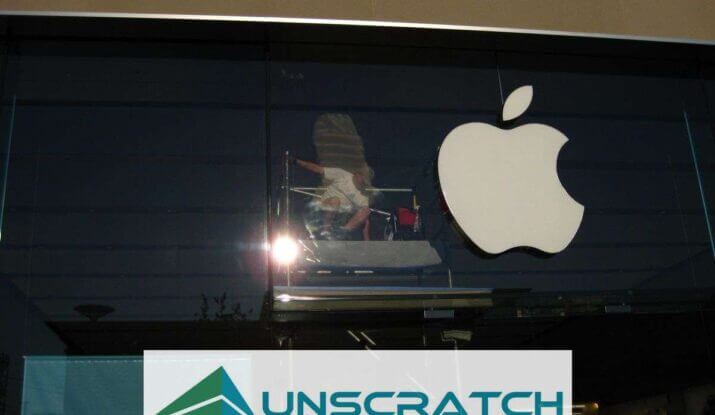Table of Contents
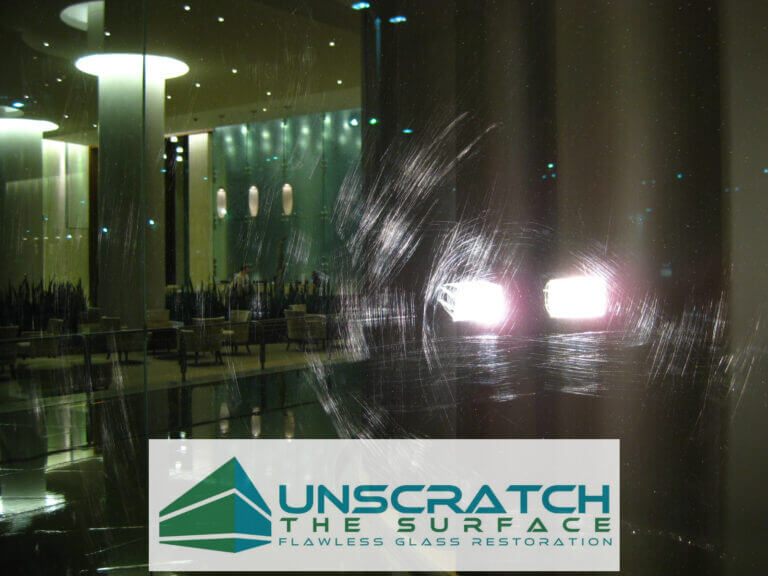
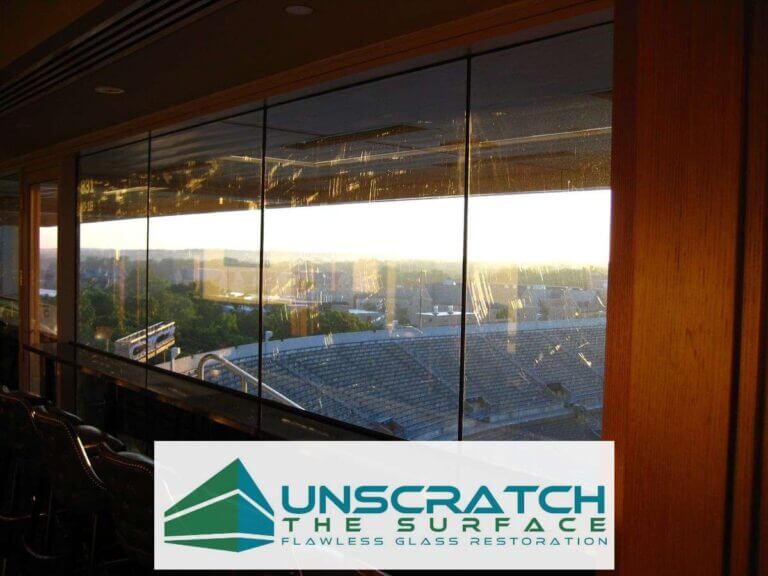
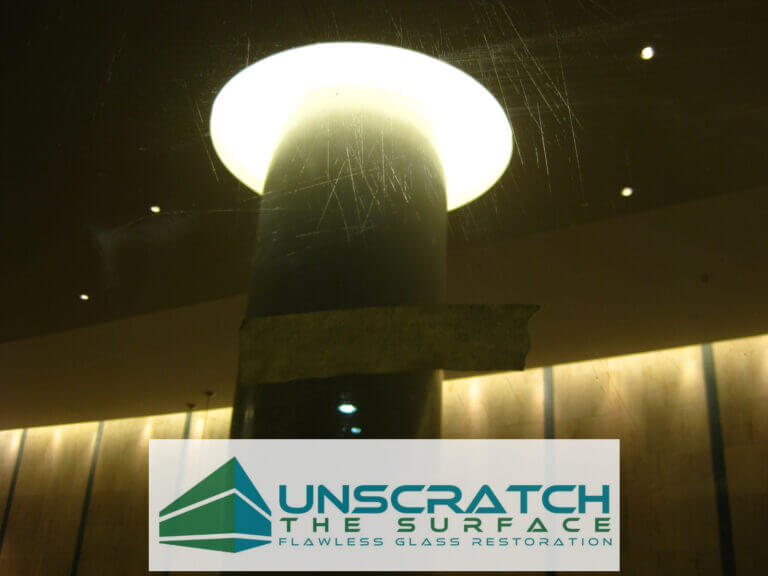
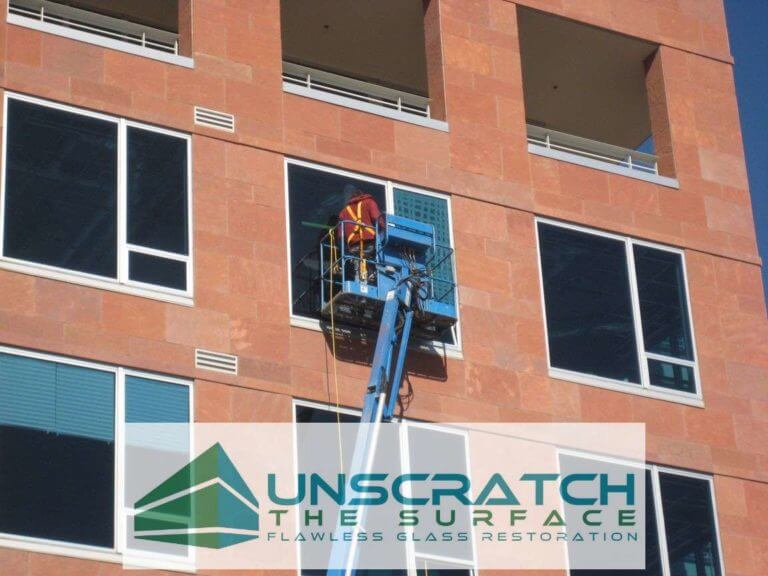

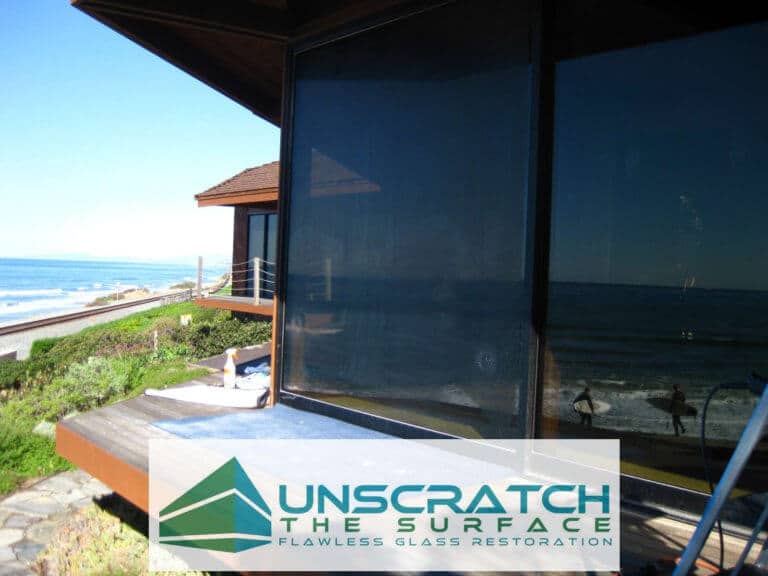


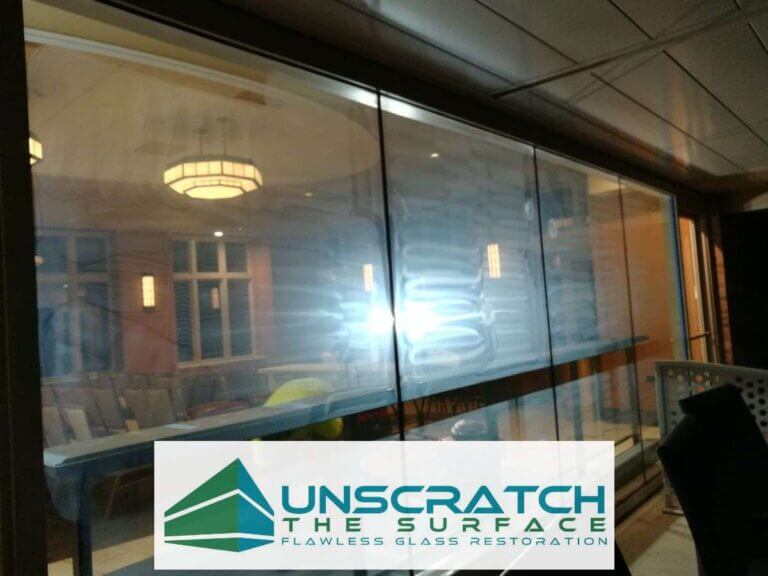
The Science of Tempered Glass: Understanding its Strengths…and why it scratches so easily!
Every picture in the above slideshow is of glass restoration in tempered glass! This article will help understand the science behind tempered glass but also why tempered glass tends to scratch so easily.
Tempered glass is nearly four times stronger than regular glass.1 It becomes so through a special heating and cooling process. This changes simple glass into a very tough and adaptable material. It’s perfect for many uses like in buildings, cars, and everyday items. Tempered glass is also more likely to get widespread scratches than annealed glass. In addition to its strength, tempered glass is designed to shatter into small, blunt pieces when broken, reducing the risk of injury. For those dealing with cosmetic issues, such as widespread scratches, specialized services offer widespread glass scratch refinishing to restore the surface. This process not only enhances the appearance of the glass but also helps to maintain its structural integrity. For those interested in maintaining the aesthetic quality of their tempered glass, there are various scratched glass repair techniques available. These methods can effectively minimize the visibility of scratches and extend the lifespan of the glass. Investing in such repairs not only improves the overall look but also preserves the functionality of the material in its intended applications. For those who are particularly concerned about the appearance of their glass surfaces, resources are available that specialize in removing scratches from glass effectively. By employing these techniques, one can ensure that the tempered glass retains its original aesthetic and functional properties, allowing it to continue serving its purpose beautifully. Additionally, regular maintenance and care can prevent scratches from becoming a persistent issue, making it easier to enjoy the benefits of tempered glass for years to come. Exploring various ways to remove scratches from glass can enhance the longevity and beauty of your tempered surfaces. Regularly assessing the condition of your glass can help catch minor imperfections before they develop into larger issues, ensuring a pristine look. Furthermore, employing preventative measures, such as using protective coatings or avoiding abrasive cleaning tools, can significantly reduce the likelihood of scratches appearing in the first place.
What is tempered glass? It’s glass that has been through a special heating and cooling treatment. This treatment creates strong pressure on the glass surface and tension inside.1 Because of this, tempered glass can bear hard knocks, resist high temperatures, and doesn’t easily break.
The strength of tempered glass comes from its process. The glass is heated to over 620°C, then quickly cooled.1 This makes the outer parts hard and the inside flexible. The result is glass that’s much stronger than regular glass.
Key Takeaways
- Tempered glass is about four times stronger than regular glass12
- When tempered glass breaks, it turns into small, safe pieces, not sharp ones1
- It is used in many things like windows, doors, and home items1
- The special process of making tempered glass makes it stronger and last longer1
- Why scratched tempered glass is our favorite to restore and remove scratches from!
- Why does tempered glass scratch so easily.
- Because it’s good with heat, tempered glass can be used in hot places13
What is Tempered Glass?
Tempered glass is known for its strength and safety. It is made by heating or treating glass.1 This makes it strong, about 3 to 5 times stronger than standard glass. It breaks into small pieces instead of sharp, dangerous shards.2
Defining Tempered Glass
Tempered glass is much stronger than ordinary glass.1 It can handle impacts better and can handle high temperatures too.4 This makes it safer for many uses.
The Tempering Process
Turning glass into tempered glass takes two main steps.12 First, it’s heated to about 620°C. At this high heat, the glass is very soft.1 The next step is quenching, which cools the glass quickly.1 This creates tension inside the glass, making it very strong.1
Advantages of Tempered Glass
Tempered glass has many benefits.124 It’s about four times stronger than regular glass. It can withstand high temperatures.12 When it breaks, it forms safe, small pieces instead of sharp ones.24
The Science Behind Tempered Glass Strength
Tempered glass is super strong thanks to how it’s made. The glass gets heated to about 620 degrees Celsius. This makes its atoms move faster and spread out. Because of this, the glass is more flexible. In the next step, the glass is rapidly cooled. This process makes the outer part hard, but the inside stays soft. These differences in hardness create a strong layer on the outside. Thus, tempered glass can handle a lot without breaking. This strong layer is spread out evenly all over the glass.5
Heat-transformed Strength
The heating part of making tempered glass is very important. High heat makes the glass’s atoms spread out and move quicker. This makes the glass able to take stronger hits without breaking. So, the glass becomes really tough. It’s much stronger than glass that hasn’t gone through the same process.5
Thermal Processes that Enhance Strength
Quick cooling after heating is vital for tempered glass to be strong. The fast cool-down makes the outside hard first, while the inside stays tense. This makes tempered glass able to resist breaks more than normal glass. The whole process makes the glass strong in a balanced way. That’s why it’s a trusted material.5
Strengthened by Temperature
The steps of heating and then quickly cooling are key to tempered glass’s might. The high heat makes the glass along with cooling causes it to form a stress. This stress pattern shields the glass from breaking under pressure.5 Each part of creating tempered glass plays a big role in making it strong. So, tempered glass is built to last, even in tough situations.
Heat Resilience and Tempered Glass
Tempered glass is super strong and can handle high heat well.5 The process of making it involves heating the glass a lot and then cooling it very quickly. This makes the glass stronger against heat.5The Heat Resilience Factor
At high heat, tempered glass’s atoms can move and spread out, staying strong.5 This makes tempered glass last longer, even in really hot places.5 It’s very useful where normal glass can’t go.Scientific Principles Behind Heat Resilience
Tempered glass is tough because of how its structure changes when heated a lot.5 This change lets the glass’s atoms move more and spread out.5 So, the glass can deal with extreme heat without breaking, staying strong.5 That’s why it’s great for places needing tough, heat-resistant glass.Safety and Shatter-Resistance
Tempered glass is safer because it breaks differently. It breaks into small pieces instead of sharp, dangerous ones.6 These small pieces are less likely to cause serious harm. Because of this, tempered glass is used in many places where safety is crucial.Reduced Risk of Injury
Tempered glass’s safety comes from how it’s made. It has surface stress that keeps it from breaking into big, sharp parts.6 This makes it much safer than regular glass, leading to its use in many industries.Shatter Pattern of Tempered Glass
Tempered glass is much stronger than normal glass. It is up to four to five times more sturdy and can handle impacts better.6 When it does break, it turns into tiny pieces that are not sharp. That’s why it’s in things like shower doors, car windows, and phone screens.6Science of Tempered Glass
Tempered glass is made in a special way. It involves heating and then quickly cooling the glass. This creates strong layers inside the glass.1 These layers can handle a lot of pressure and heat without breaking. The way tempered glass is created shows how smart material engineering is. It’s thanks to new glass technology. This glass is much stronger than regular glass. It needs to be really tough to be called safety glass.2 7 The materials in tempered glass matter a lot. It includes things like quartz and other substances needed for the heating process. The glass can even be as strong as concrete walls by the water, which is very strong.Versatility and Applications
Tempered glass is highly versatile and used in many industries. Its strong, safe, and can handle heat well. This makes it perfect for buildings, cars, and everyday products.3Architectural and Construction Uses
In buildings, it’s great for windows, doors, and more. It’s strong and safe. So, even if it breaks, it won’t hurt people a lot.3Automotive and Transportation
In cars and trucks, tempered glass is for windows and windshields. It’s tough against hits and changes in temperature. If it breaks, it crumbles into small pieces, making it safer for people inside.8 This glass type is good for industrial things too. For example, it works well in furnace windows, staying clear even in hot places.8Consumer Products and Appliances
It’s in home products like tables, shower doors, and oven windows. These things need to be long-lasting and safe. Tempered glass is made to be stronger than regular glass. That’s why it’s chosen for these items.8 Overall, tempered glass is a key material in many businesses. It’s chosen for its strength, safety, and ability to handle heat. These qualities make it perfect for modern needs.38Advantages Over Traditional Glass
Tempered glass is stronger than traditional glass. Its strength increases by 3 to 7 times.8 This makes it durable and hard to break. It can deal with impacts and weather better.8Increased Strength and Durability
It’s up to four times stronger than untempered glass,8 with a minimum compressive stress of 10,000 psi.8 This durability means it holds up under more pressure and impacts.8Improved Safety Features
Tempered glass is much safer. When it breaks, it shatters into tiny, smooth pieces.8 This is unlike regular glass that breaks into sharp, dangerous shards.8 That means less risk of getting hurt if it breaks.Resistance to Heat and Chemicals
Also, heat and chemicals don’t bother tempered glass much. It can handle high heat and some harsh chemicals.8 This makes it great for use in hot places or with chemicals.8 So, tempered glass wins over traditional glass in many ways. It’s great for buildings, cars, and many other things.The Tempering Process Explained
The process of turning regular glass into strong and heat-resistant tempered glass has two main steps.1 First, the glass heats up in a special oven to about 620°C.1 At this heat, the glass gets soft, and its atoms move quickly and spread out. This makes it ready for the next step. During the heating process, the glass actually begins to soften. If there is any glass dust or debris on the glass, it will now become fused permanently to the glass surface. We call this “fabrication or fabricating debris“. This is where the scratches on tempered glass ultimately come from.Heating Stage
Next is the quenching part. The hot glass cools down really fast with air or chemicals.1 As it cools, the outside turns hard while the inside stays soft. This creates a strong tension between the outer hard layers and the inner soft layers. This tension is what makes tempered glass very strong and tough.1 This cooling process is key to tempered glass’s strength.Quenching Stage
The process to make tempered glass strong and heat-resistant has two main parts.2 To be fully tempered, 6-mm glass needs strong pressure on its surface or edge.2 Safety glass must have very high pressure on its surface.2 These pressures stop cracks from growing, making the glass very safe.Design Considerations for Tempered Glass
Tempered glass has many benefits but comes with design challenges. Size and thickness limits are important in tempered glass design. Because of how it’s made, tempered glass can’t be changed much once it’s done.3Size and Thickness Limitations
The special process used on tempered glass makes it strong yet hard to adjust. It’s important to get the size and thickness right from the start. This ensures it fits the job well.3Optical Distortion
Tempering can make glass change how light moves through it. This might matter a lot in designs that need clear, true light. Think about this for glass in architecture or some products.3Edge Finishing
The edges of tempered glass need extra care. They could be weaker and more likely to break. Good edge work like polishing keeps it safe and sound.3 Knowing about these issues helps pros use tempered glass well. They can highlight its best parts while handling its unique limits.Why Tempered Glass Scratches So Easily
Over 95% of all the scratched glass we repair, resurface, and restore is actually tempered glass! Most people think : Most people think that only regular glass can be scratched, but tempered glass is surprisingly vulnerable to damage as well. With our specialized scratch removal techniques for glass, we can effectively restore its clarity and finish, making it look almost new again. This not only enhances the aesthetic appeal but also extends the lifespan of the glass, providing both practical and financial benefits to our clients. Our experienced technicians are trained in the latest restoring scratched glass techniques, ensuring that even the most stubborn scratches can be eliminated. By utilizing advanced tools and eco-friendly materials, we prioritize not only the quality of our work but also the safety of our environment. Whether it’s for residential or commercial applications, our dedication to excellence in glass restoration guarantees satisfaction and a renewed appearance you can trust. Our commitment to using the best glass restoration techniques means that we stay updated with industry advancements and innovations. This allows us to tackle a wide range of scratches and imperfections, regardless of the glass type. With a focus on customer satisfaction, we strive to provide tailored solutions that meet the unique needs of each client, ensuring their glass surfaces are not just restored, but enhanced for durability and resistance to future damage. In addition to our comprehensive scratch removal capabilities, we also offer a glass restoration services overview that highlights our commitment to quality and customer care. Our team works closely with clients to assess their specific needs, recommending the most suitable solutions for each unique situation. By combining our technical expertise with a customer-centric approach, we ensure that every project not only meets but exceeds expectations, ultimately fostering long-lasting relationships with our valued customers.- Tempered glass is too hard to remove scratches.
- Tempered glass can’t be resurfaced.
- Tempered glass scratches easily because it’s softer than annealed glass.
Enhancing Glass Strength Through Scratch Removal
Glass plays a critical role in architectural and automotive applications, where it must withstand mechanical and environmental stresses. Historically, scratch removal methods often compromised the strength of glass, leading to concerns about its load-bearing capacity and long-term reliability. Early techniques lacked precision, sometimes causing optical distortions or thinning of the glass, which weakened its structural integrity.Understanding Structural Integrity in Glass Restoration
Modern advancements in glass restoration, such as those employed by Unscratch the Surface, have revolutionized the process. These techniques focus on precision and control, ensuring that only minimal amounts of material are removed. For example, highly controlled abrasion methods remove approximately one thousandth (0.0001 inches) of material per pass, making the process minimally invasive and significantly safer for the glass’s structural integrity.Tempered Glass: A Unique Challenge
Tempered glass, widely used for its enhanced durability in demanding environments, requires special care during scratch removal. The outer layer of tempered glass, known as the tempering envelope, is crucial for its strength and resilience. Modern restoration methods ensure this envelope remains intact even when addressing severe damage. By preserving this layer, tempered glass retains its original strength while eliminating imperfections that could act as stress points. Interestingly, removing scratches from tempered glass can enhance its overall strength. Scratches create weak spots that may propagate under stress, potentially leading to cracks or fractures. By eliminating these flaws, the restoration process strengthens the glass and improves its resistance to future stresses.Techniques That Transform Glass Restoration
Today’s glass restoration techniques combine precision with innovation to deliver superior results:- Dry Grinding: This method avoids liquid lubricants, reducing risks of optical distortion and messy cleanup. It ensures a perfectly flat abrasive surface for distortion-free repairs and is particularly useful for installed panes.
- Advanced Polishing Compounds: Materials like cerium oxide are used to buff out scratches effectively while preserving clarity.
- Specialized Equipment: Commercial-grade polishers operate at controlled speeds to prevent overheating or further damage.
Aesthetic and Structural Benefits
Modern scratch removal techniques not only restore the visual appeal of glass but also reinforce its structural integrity. By meticulously removing scratches without compromising the thickness or strength of the material, these methods ensure that the glass remains safe and reliable for its intended use. Whether addressing minor blemishes or significant widespread scratch damage, professional services like Unscratch the Surface provide solutions that enhance both appearance and performance. With precise tools and techniques tailored to each situation, these services elevate glass restoration to an art form.Conclusion
Glass restoration has evolved from a simple aesthetic fix to a sophisticated process that strengthens and preserves structural integrity. By employing advanced techniques like controlled abrasion, dry grinding, and specialized compounds, professionals ensure that restored glass is not only visually flawless but also robust enough to endure future stresses. Trust Unscratch the Surface for expert solutions that combine safety, reliability, and beauty. Through continuous research and development, companies like Unscratch the Surface also provide valuable insights through their case studies in glass scratch repair, highlighting successful restorations and innovative techniques. These case studies not only demonstrate the effectiveness of their methods but also educate clients on what can be achieved with the right expertise. With a commitment to excellence, Unscratch the Surface ensures that every project contributes to a growing portfolio of transformative results in the glass restoration industry. The science of tempered glass is very interesting. It shows us how to make glass super strong through smart processes. These methods change normal glass into something with unique strength and durability. The main step is to heat the glass up a lot, then cool it quickly. This creates special stresses inside, making it up to four times tougher than regular glass. This type of glass is also safer. When it does break, it shatters into pebble-like pieces instead of sharp shards. It can handle heat better and lasts longer against weather and rough use. That’s why it’s used in many places and industries. You can see tempered glass almost anywhere. Places like homes, cars, and the food industry use it a lot. In the U.S., there are rules that say when and where to use this glass for safety. It’s also common in places like bars to prevent glass from turning into weapons. Plus, it’s in popular things like your phone’s screen. Knowing about tempered glass helps lots of professionals do their jobs better. They can pick the right glass for their projects with this knowledge. The main benefits of tempered glass are its strength, safety, and wide use in many areas. This makes it key in designing products that are both safe and durable.Source Links
- https://www.scientificamerican.com/article/how-is-tempered-glass-mad/
- https://en.wikipedia.org/wiki/Tempered_glass
- https://www.ny-engineers.com/blog/tempered-glass-properties-and-applications
- https://www.windowfilmdepot.com/blog/what-is-tempered-glass-and-what-its-used-for/
- https://www.business-money.com/announcements/thermal-toughening-the-science-behind-tempered-glass-strength/
- https://repairman.ae/blogs/news/shatterproof-secrets-unveiling-the-science-behind-tempered-glass
- https://ceramics.org/ceramic-tech-today/glass-1/the-science-of-elemental-tempered-glass-and-causes-of-failure/
- https://www.swiftglass.com/blog/what-is-tempered-glass/

